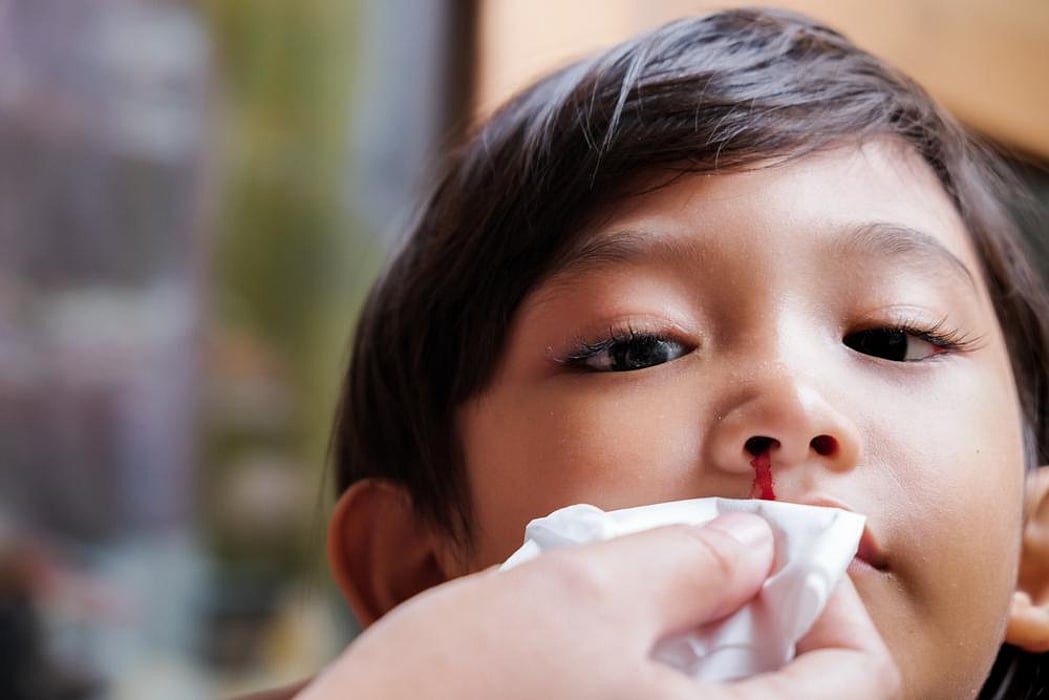Nosebleed (Children)

How do I stop a nosebleed?
First, have your child sit or stand up to reduce the blood pressure in the veins of the nose so that bleeding slows. Have him lean forward and spit out any blood. For a young child, gently pinch the nose shut near the tip with a tissue or clean washcloth, using your thumb and index finger to hold it closed. (Older children can do this themselves.) Remind your child to breathe through his mouth and continue to lean forward spitting out any blood that has accumulated in his mouth or throat. Apply gentle but constant pressure for a full 10 minutes. If your child seems scared or worried, reassure him that there's no danger.
Two things to avoid: Don't tilt your child's head back; that allows blood to flow down the throat and may cause vomiting. And don't pack the nose with cotton after a nosebleed; it can stick and cause bleeding to resume when it's later removed and any clots that have formed are disrupted.
If re-bleeding occurs, have your child blow his nose to remove any clots that may have formed and repeat the steps above. If the bleeding continues longer than 20 minutes despite following these steps, call your child's doctor immediately.
Are frequent nosebleeds something to worry about?
No. Nosebleeds are common in children. Sinus infections, colds, allergies, or dryness of the nasal lining makes them more likely to occur. Young children often make matters worse by rubbing or picking their noses. If your child gets a nosebleed at night, you may find dried blood on the pillowcase in the morning. Again, there's no reason to worry.
However, you should call the doctor immediately if your child gets a nosebleed from a blow to the head or a fall. Also call the doctor if your child has just started taking a new medicine and begins to get a lot of nosebleeds. If nosebleeds become a frequent problem or are occurring more often than usual -- especially if they're accompanied by other symptoms, such as bruising -- check with the doctor.
How can I prevent nosebleeds?
If the air in your home is dry, use a humidifier in your child's room at night. You may also want to apply a small amount of petroleum jelly to the center wall inside his nose to relieve dryness. If your child has a habit of picking his nose, keep his fingernails trimmed so he's less likely to injure the lining of his nose.
Further Resources
KidsHealth.org
http://kidshealth.org/parent/firstaid_safe/emergencies/nose_bleed.html
References
Robert H. Pantell M.D., James F. Fries M.D., Donald M. Vickery M.D., Taking Care of Your Child: A Parent's Illustrated Guide to Complete Medical Care. Da Capo Press.
American Academy of Pediatrics, HealthyChildren.org. Chronic Nosebleeds: What to Do. http://www.healthychildren.org/English/health-issues/conditions/ear-nose-throat/Pages/Chronic-Nosebleeds-What-To-Do.aspx
Mayo Clinic. Nosebleeds. http://www.mayoclinic.com/health/first-aid-nosebleeds/HQ00105
Related Posts
El café no aumentará el riesgo de un nacimiento prematuro, pero fumar ciertamente lo hará: estudio
VIERNES, 29 de septiembre de 2023 (HealthDay News) -- Fumar durante el embarazo...
Adding Darolutamide Ups Survival in Metastatic Prostate Cancer
WEDNESDAY, Feb. 23, 2022 (HealthDay News) -- Survival is prolonged in patients...
Poll Finds Nearly Half of Americans Unprepared for Medical Emergency
FRIDAY, Jan. 20, 2023 (HealthDay News) -- Nearly half of American adults are not...
